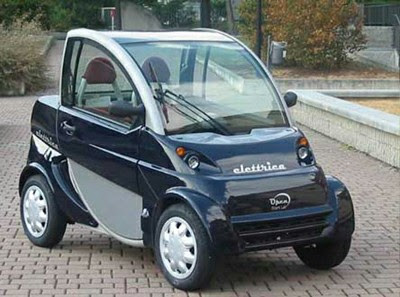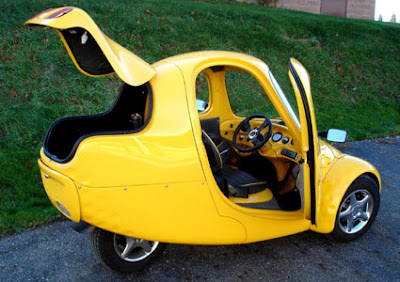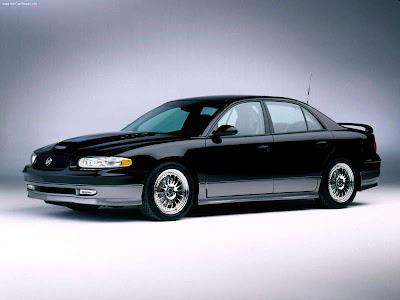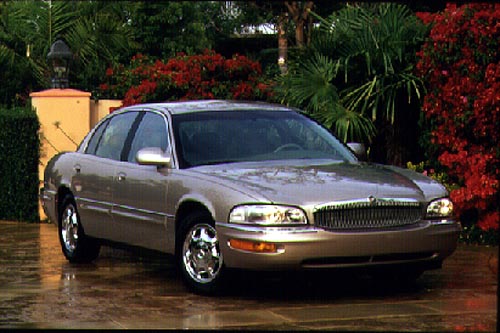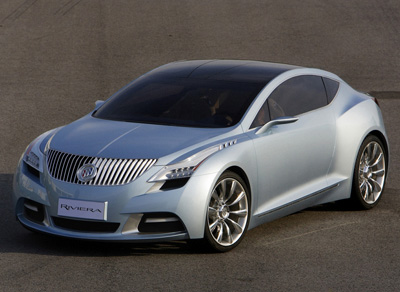Saturday, September 4, 2010
Friday, September 3, 2010
Challenge on the Next City
One of our readers points out that cutting carbon footprint at home, getting rid of the car, and emphasizing walkability is all well and good if you’re mobile, but what if walking is a problem? Sit home and mope?
While talking about automated mobility may be a slippery slope in the next city, let’s take a look at what’s out there. Actually we are now beginning to see the production of quite an array of electric vehicles for the next city (and without a $25 billion federal subsidy…).
We have many qualms. Though some are very inexpensive, small, and light, they are certainly not built with sustainable materials in sustainable ways – and none of the manufacturers is touting the cradle-to-cradle nature of their production (recycled, recylable, renewable) – but it strikes us as better than a Hummer, by some margin.
Electric Smart car. Just another car in a smaller package, or a new way of thinking? $35k.
Our favorites are the littlest, the lightest, and smallest. Kind of like golf carts that are enclosed. These are the ones that allow for local urban mobility without pretending that we can commute for two hours one-way, or make a weekend run from DC to Boston. For that, in the next city, we’ll need something else – not cars – like trains. If the next city is to be about people, and local life, and neighborhoods, and sustainability, and not cars and all their attendant destruction, then thinking really small seems like the only way at all.
Startlab’s Open Street model. A bit more than $22k.
There is one available soon, supposedly, called the Tesla. Hard to suppress a laugh at that name… Anyway, the manufacturers claim over 200 miles between charges and a top speed of 125 mph. Cost is north of $110 grand. This sounds more like substitution than rethinking – greenwashing if you will. Here we can see what we can do, but not necessarily what we should do.
Tesla: 0 to 60 in just over 3 seconds, top speed 125 mph.
Anyway, dear reader, there are options for those with mobility challenges, options that permit participation in the next urban life without pumping breathtaking amounts of carbon into the air. In the end though, these little electric devices need to be coupled with a new way of making our communities – destinations within your neighborhood that are just a few blocks away, not across town or out in the suburbs. For many, even city dwellers in most cities in this country, walking a half mile or a mile doesn’t get you to the garlic you need, or the trattoria where you want to be. This must be the highest priority as we reshape the places where we live and work. Mr. Kamen, we need a two-door Segway with wipers and a heater, please.
Myers Motors NMG (no more gas) one seat electric car – a tricycle. $30k.
Sport Car Pictures

2011 Seat IBE Coupe Concept


 Now, you can see photos of Seat IBE Coupe Concept showed at Paris Motor Show. Improvements over the first Seat IBE Concept, which was shown in Geneva earlier this year, include refinements to the design and technology, while the Paris Show car now also sports an interior.
Now, you can see photos of Seat IBE Coupe Concept showed at Paris Motor Show. Improvements over the first Seat IBE Concept, which was shown in Geneva earlier this year, include refinements to the design and technology, while the Paris Show car now also sports an interior.Both exterior and interior are characterised by their focus on key elements, by a clear and precise architecture, by modern technology and by materials that are as high-quality as they are ecological.
Come with measuring in at just 3.83 meters (12.5 ft) in length, it is smaller than Volkswagen’s Scirocco. Utilizing a 75 kw (102 hp) electric drive system, the concept is good for 130 km (81 miles) on a single charge. Acceleration from 0 to 100 km/h (0 to 60 mph) can be achieved in 9.7 seconds.
While its exterior design has been tweaked with a restyled lower fascia and new LED headlamps and tail lights. Furthermore, the car is now finished in a more eye-catching cherry-red color.
Thursday, September 2, 2010
2010 Jaguar Sports Cars XKR 75



2010 Jaguar Sports Cars XKR 75



2010 Jaguar Sports Cars XKR 75



2010 Jaguar Sports Cars XKR 75



2010 Jaguar Sports Cars XKR 75



2010 VolksWagen Cars Beetle Bio-Bug Powered by Sewage Waste




2010 VolksWagen Cars Beetle Bio-Bug Powered by Sewage Waste













